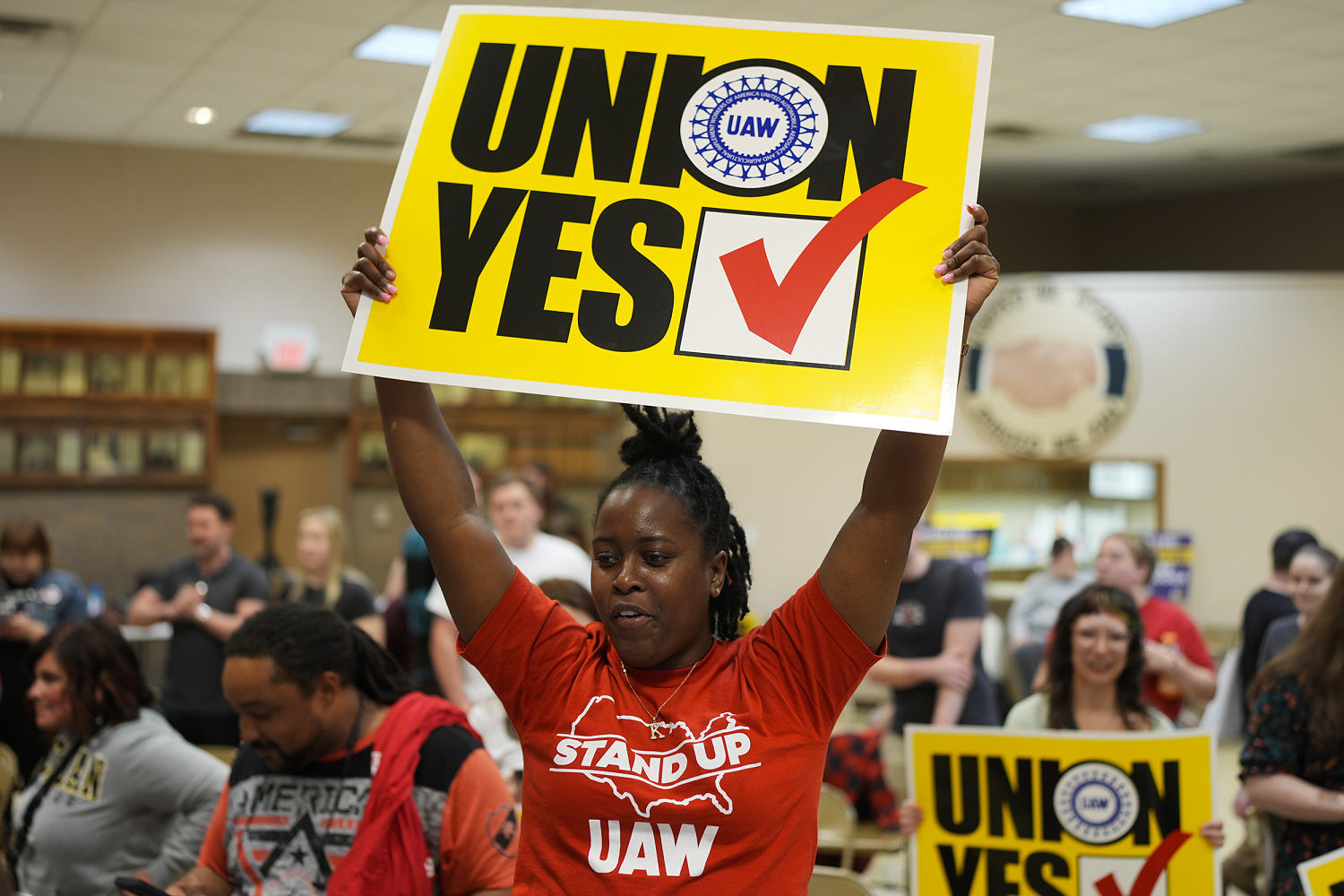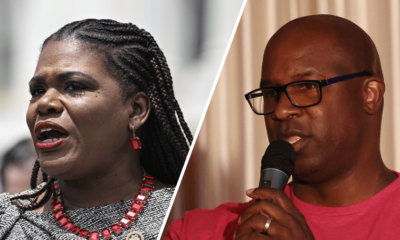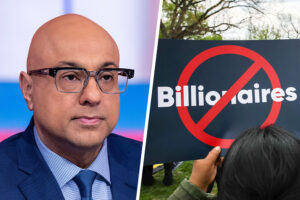The Dictatorship
The straightforward reason why Americans struggle to unionize the workforce

On this Labor Day, more than any in recent memory, there is widespread bipartisan support in Congress and across America for the right to be in a union.
Unions are as popular now as they have ever been and they’re even receiving support from Republicans in Congress like Missouri Sen. Josh Hawley. Yet the labor law that’s currently on the books — the Wagner Act of 1935 — isn’t strong enough to protect workers who want to unionize.
The basic problem is straightforward: Employers don’t want their workers to unionize and are generally willing to fire union supporters to stop a union drive. That means that trying to form a union means risking your job, which is a risk that most workers rationally don’t want to take. That’s especially true when the law is too weak to provide recourse to pro-union workers who do get fired.
The share of workers who are in a union is below what it was before we had any labor laws.
The combination of hostile managers and weak labor laws equals very low unionization rates — in fact, the share of workers who are in a union is below what it was before we had any labor laws. These low union rates account for a great deal of the economic and political inequality that plagues American life.
Building a labor law that actually enables workers to form unions requires a lot more than tinkering with the existing systems. Regardless of party, lawmakers who are serious about making sure workers have a clear path to joining a union need to support reforms more fundamental than any we’ve seen since the New Deal.
These changes would take a two-step approach to tackling the root problems with organizing a union. First, make it easier for workers to unionize and win a collective bargaining agreement even if their employers oppose those efforts, and second, reduce the incentives for employers to fight union organizing drives in the first place.
To accomplish the first goal, Congress must increase penalties on employers that fire pro-union workers, limit employers’ ability to engage in union busting, and change the rules of collective bargaining to make it more likely that workers can win a contract. Many of these proposals are contained in the Protecting the Right to Organize (PRO) Actwhich passed the House twice when Democrats last controlled the chamber, but has languished in the Senate.
Passing the PRO Act is just the start, however. One powerful idea would be to “flip the default.” Rather than assuming (as we do under current law) that workers want to be nonunion, we could start with the equally plausible assumption that workers want to be union. In such a system, we’d still hold union elections. But, like in politics where voters choose between representatives, workers would vote on which union they want to represent them not whether they want representation. And to ensure real freedom of choice, workers could run organizing campaigns to get rid of union representation altogether — if that’s what they prefer.
Labor law can also help reduce the reasons employers oppose unionization in the first place by changing the way unions and employers bargain contracts. Currently, workers in the U.S. who want to form a union must do so at their individual workplace or their individual employer. For example, if McDonald’s workers want a union, they’d have to organize one at a single McDonald’s restaurant. But if that McDonald’s is the only fast-food restaurant in the area to be unionized, then it likely would need to pay its workers more in wages and benefits than its local competitors.
Finally — and here there may be less bipartisan agreement — we need to shore up unions’ ability to act politically.
But in many developed economies, unions organize and bargain across an entire industry, not individual businesses. In this sectoral bargaining regime, no firm in a market is disadvantaged by being union because every firm in the market is covered by the union contract. Thus, no firm needs to see their workers’ organizing as an existential threat to their ability to compete.
Labor law reform, moreover, can’t just be about private sector workers, especially given the critical role that public employees have played in the labor movement. Congress therefore needs to fix a loophole in our laws that President Donald Trump has exploited to weaken federal unions. Using what was supposed to be a narrow exception for workers on the front lines of national security, Trump has denied almost 1 million federal employees collective bargaining rights. Any new labor law reform should include a new and clearer exception that is limited to just those workers traditionally excluded from the federal sector collective bargaining system — those working for the CIA, NSA, DEA, subdivisions of the Defense Department and the Treasury, and other employees in the intelligence field.
Speaking of the president, earlier this year, Trump fired National Labor Relations Board member Gwynne Wilcox, a Joe Biden appointee, years before the end of her term. When Congress created the board in 1935, it assumed that the board would be an independent agency, but an NLRB populated by appointees serving at the pleasure of the president is a different animal. The Supreme Court’s conservative majority has consistently granted Trump the power to jettison the independence of agencies like the NLRB (defying decades-old precedent). New labor laws must address these implications. While it’s unclear what form a federal labor authority should take in this new context, future reform should consider alternatives — such as granting workers a private right to sue employers — so they’re not dependent on a politically biased agency.
Finally — and here there may be less bipartisan agreement — we need to shore up unions’ ability to act politically. Without unions working as political actors, American workers would not be protected by minimum wage and overtime laws, antidiscrimination laws, or health and safety laws, nor would they enjoy the legal right to time off from work for family and medical emergencies. Unions secure these bread-and-butter protections for American workers through collective bargaining, yes, but also through electoral politics. And in a political system awash in corporate money, it is shortsighted to think that unions can do their job exclusively through collective bargaining.
As Justice Felix Frankfurter wrote more than 60 years agothe political activity of unions is “activity indissolubly relating to the immediate economic and social concerns that are the raison d’etre of unions.”
Across party lines, Americans support unions. If Democrats in Congress continue to stand up for labor rights, then it would only take a handful of Republicans to create the majorities needed to pass the reforms outlined in this piece. If Republicans are serious about supporting workers and their unions, then they need to stand up and address the root causes of the current system’s failures. For years, lawmakers on both sides have promised to fight for the working class. But words are not enough. Now is the time for action.
Sharon Block
Sharon Block is a professor of practice at Harvard Law School, and the executive director of the Center for Labor and a Just Economy. She is a former member of the National Labor Relations Board.
Benjamin Sachs
Benjamin Sachs is the Kestnbaum Professor of Labor and Industry at Harvard Law School.
The Dictatorship
Drowning was already a problem in the U.S. RFK Jr. may have made the issue worse.

Labor Day weekend is one of the deadliest holiday weekends for drownings and water-related tragedies. But with the recent firing of the Centers for Disease Control and Prevention’s drowning prevention teamAmericans are losing a key source of information that helps save lives.
Research and drowning data drive our programming at the National Drowning Prevention Alliance, and until now, the CDC’s drowning prevention team played a critical role in our efforts. The agency and that team have helped us better understand who is drowning, where they’re drowning and why, so that we can develop effective drowning prevention programs. That’s why we find it appalling that drowning prevention team was recently fired and its work immediately halted.
We find it appalling that the CDC drowning prevention team was fired and its work halted.
It’s equally outrageous to hear that the entire program appears to be missing from the 2026 budget.
This so-called cost-cutting effort will have a ripple effect across the entire water safety community. An already underresourced field has now lost some of our most brilliant leaders and its access to data that can help us save lives. When one considers the country’s alarming drowning statistics and the fact that drowning costs the U.S. economy more than $50 billion a yearby the CDC’s own account, these cuts make zero sense.
Drowning is a silent yet preventable global epidemic. The information we do have from the CDC tells us that every year, the U.S. loses over 4,000 people of all ages and in all kinds of water to unintentional drowning. Drowning is the leading cause of death for children ages 1 to 4 and remains a leading cause of death for older children, teens and adults.
We should all be alarmed at recent CDC statistics that show that between 2019 and 2022, there was a 28% increase in drowning incidents among children ages 1-4 and a 19% increase among older adults ages 65-74. Between 2019 and 2021, there was a 28% increase in drowning rates for Black people. American Indian or Alaska Native people had higher drowning rates than any other race or ethnic group, and Black people had the second highest drowning rates.
According to a 2017 study from Columbia University, children with autism are 160 times more likely to drown than the general pediatric population. These sobering statistics are not just numbers; they are loved ones lost to preventable tragedies and represent families and communities profoundly impacted by these drownings.
We believe wholeheartedly that it is critical to increase, not decrease, federal resources for research and drowning prevention. That way, water safety advocates working across the U.S. will have the data, research and evidence-based strategies needed to provide water safety education and drowning prevention programs that work. We will continue to work together to prevent drowning so that all people have the knowledge and skills to safely enjoy the water. We, and I personally, do this work in honor of those lost to and impacted by drowning.
We believe it is critical to increase, not decrease, federal resources for research and drowning prevention.
Labor Day weekend is another reminder of how vital it is that individuals and families are equipped with basic water safety knowledge.
Fortunately, drowning is preventable. Unfortunately, there is not one, single solution to prevent drowning, so we recommend using layers of protection. Here are some simple water safety tips to share with your family and friends so that you can have fun while being safer in and around all kinds of water and aquatic environments.
- Barriers and alarms: These are a first and critical line of physical defense to restrict unauthorized access to a pool, spa or other body of water. These include: four-sided fencing; self-closing and self-latching gates; door, window and pool alarms, plus wearable alarms; and AI drowning detection systems. We know that 70% of drownings among young children occur during nonswim times, so these are essential.
- Supervision: Constant, capable and undistracted supervision is another critical layer of protection needed to prevent drowning. Always designate a water watcher when kids are in, on or around the water whose only job is to watch the water and be able to respond immediately in case of an emergency.
- Learn to swim: People of all ages should learn to swim and acquire basic water safety and survival skills, like floating, treading water and safely entering and exiting the water. It is also important to know your abilities and be able to navigate different aquatic environments, not just pools.
- Wear life jackets: When in or around open water or boating, wearing a properly fitted, U.S. Coast Guard-approved life jacket is essential. According to 2018 statistics from the Coast Guard, more than 80% of open-water drownings involve individuals who were not wearing life jackets. Life jackets save lives.
- Emergency preparedness: Learn how to recognize a swimmer in trouble and make sure you’re always able to call for help. Knowing CPR with rescue breaths and basic water rescue skills can be the difference between life and death.
Free water safety resources and educational materials are available at www.ndpa.org.
The National Drowning Prevention Alliance asks for the CDC drowning prevention team to be reinstated. The drowning prevention community is mobilizing our resources, partnerships and collaborative efforts to keep this work going, while hoping that our CDC colleagues will soon return. For now, though, we must use the data we have, our collective expertise, proven strategies fueled by the courage and stories of families who have lost a loved one to drowning or who have been impacted by a preventable water-related tragedy to reach families and communities.
Alissa Magrum
Alissa Magrum is the executive director of the National Drowning Prevention Alliance and has been working full time in water safety and drowning prevention for the last 15 years. She is an avid “waterman” and a fierce advocate for families and communities impacted by drowning.
The Dictatorship
Taylor Swift’s about to find out what a lot of married women already know

I might be the only one who isn’t bursting at the seams with unbridled joy over Taylor Swift’s engagement news.
I mean, sure. If Swift is happy, the only appropriate response is to be happy for her. But I wonder if she’s about to find out firsthand what many middle-aged married women already know: that many of Swift’s love songs really do paint an impossible picture.
To be sure, romantic love is real. Science believes that it lasts for about two years, tops. And building a life with someone you love can be great, if you’ve chosen the right person. But science has also discovered something else: when it comes to hetero unions, men stand to benefit much more than women do from marriage. And it is widely known that single women are thought to be happier than their married counterparts.
When it comes to hetero unions, men stand to benefit much more than women do from marriage.
Perhaps I’m just a curmudgeon who missed her nap today (true on both counts). When I said yes outside of a Roman gelateria in 2018, my husband on one knee with a comically large fake diamond (he didn’t want to travel with a real one), I was happy. I wasn’t overjoyed — who has the energy for that? — but I was happy. We had already been together for six years, and I honestly thought he’d never ask. I couldn’t imagine my life with anyone else.
I also naively thought that getting married might make some of our bigger problems go away. We were in a long-distance relationship at the time. Saying “I do” would close the gap, right? Well, it did. First major problem solved!
But my husband is also an avoidant Midwesterner while I’m an assertive New Yorker. I soon learned that avoidant personalities are all too happy to sweep any and all problems under the rug in the hopes that everyone forgets in the name of peace and harmony. And as we both learned (the hard way), that tactic doesn’t work on someone who’s not afraid of conflict. Our personalities were laid bare, and there was nowhere to hide.
Our first four years of marriage turned out to be the hardest of our relationship. In many ways, marriage creates more problems than it solves. No one knows that more than, well, people who are married. There’s a lot of life to live after the dress fittings and sappy vows. And much of it is rife with some level of conflict and negotiation. Because no matter who you are, that’s what happens when two people blend their lives. It’s inevitable.
I do not intend to rain on Swift’s parade, but I do wish someone would have been brave enough to sit me down for some real talk about what many married women know firsthand: There’s nothing magical about marriage. Nothing. Not one thing. Even for the happiest couples.
And while Swift and Travis Kelce’s individual and combined net worth may shield them both from some of the more unpleasant realities that the rest of us contend with (including something as simple as the suffocation of sharing a home when sometimes a girl just wants to be alone for a week, a month, or a year), nothing will shield them from the reality that life is not a music video. Expecting an eternal, fiery, breathtaking love to sustain much beyond the vows is an exercise in delusion.
I can’t speak to her personal expectations, but Swift is in the business of creating fantasies, evidenced by her extensive repertoire of her pining for a fairy tale kind of love. Her own life is something of a fantasy, if measured by fame and success alone. But expecting marriage to live up to our cultural ideals is a fool’s errand. I say this as someone who married at 39 years old, and long after that rush of falling in love wore off after the first couple of years.
I am, without a doubt, happily married. So far as I can tell, I have chosen wisely. My spouse and I share a lot of happy moments and copious laughter, for which I am grateful. We love each other fiercely and work hard to give each other good lives.
But despite our love and commitment to each other, most of our days together are marked by drudgery, negotiation, mild arguments, odd smells, and tedium — with a healthy dose of mind-numbing irritation that has made me want to throw in the towel more times than I can recall. I have no doubt that he has experienced the same — because we talk about it.
Despite my husband and I truly believing that we’ve chosen wisely and at the right time, we are in couples therapy working out the very real and sometimes deal-breaking kinks. Marriage is rife with such realities, and celebrities don’t get a pass on these basic truisms. No amount of money or fame can shield a couple from the landmines that challenge even the happiest of marriages. Swift and Kelce are no exception, no matter how much we want to believe they are.
And as the rest of us hawk and gawk and speculate and drool over this couple’s decision to do life together, we need to calm down. They’re about to embark on a complicated and maddening journey. Money and fame do not, will not, and cannot make this less true.
I hope it works out for them. But no one who chooses to exchange a teary “I do” is immune from any of the hard stuff that marriage can and does throw at a couple, including those private moments where one is forced to contend with whether or not they’d do it all over again if they had a time machine.
According to celebrity psychotherapist Esther Perelwhen we marry, we are signing up for a lifetime of contradiction. We are placing all of our hopes, expectations, and dreams onto a single person. And for Perel, our “litany of expectations is a grand setup for failure.” I hope the women in Swift’s circle are having honest discussions with her about what marriage is, and what it isn’t. What it can be, and what it can’t be. What it gives to a person, but also what it takes away.
I wish Swift only a life filled with the kinds of fairy tales that have made her impossibly famous. And when the dust settles, and reality sets in, I’ll be curious to hear what music she creates in about 10 or 15 years’ time.
Christina Wyman is a USA Today and Publishers Weekly bestselling author and teacher living in Michigan. Her debut novel, “Jawbreaker,” was a Publishers Weekly Best Book of 2023. Her sophomore middle-grade novel is “Slouch.”
The Dictatorship
Organizers in Chicago shift Labor Day rally to protest looming federal takeover


By Are Salam
With President Donald Trump threatening to “straighten out Chicago” and flood the city with federal law enforcement, local groups in the city are preparing to respond.
Organizers in Chicago already had plans for a “Workers over Billionaires” rally — one of nearly 1,000 similar rallies taking place across the country on Labor Day — long before Trump announced his intention to militarize American cities. But now those threats have become the focus.
The Chicago Teachers Union, which is leading the rally, has prepared a plan that includes educational materials so residents know their rights, a family safety network and a patrol.
“I’ve seen L.A., and I’ve seen Washington, D.C., and the pretext is always this phantom undocumented individual. And then after they established the pretext, they set up shop in Black communities, and they violate the constitutional right of Black citizens,” CTU President Stacy Davis Gates told BLN.
Davis Gates said she mostly fears for the safety of the city’s youth should a federal takeover happen, which she said would be “scary.” She added that the Trump administration’s plans would not serve the community.
“The federal government can do a lot to help Chicago,” Davis Gates said. “We’re not asking for a militarized force. We’re asking for SNAP benefits to be restored. We’re asking for the Department of Education to be funded and resourced so that special education children have recourse when their school districts fail to educate them appropriately.”
The Trump administration has reportedly already requested that a military base near Chicago be available to provide support for immigration operations in the area.
As of Thursday, Illinois Gov. JB Pritzker said he received “no calls from the White House, from the federal government, from anybody who might be in charge of some sort of troop movement.”
Illinois Attorney General Kwame Raoul told MSNBC’s Ana Cabrera on Wednesday that “there are prerequisites to federalizing the National Guard” and said “no circumstances exist that would require Trump to send the National Guard into Chicago.”
“We didn’t elect a king,” he added. “We elected a president.”

Erum Salam is a breaking news reporter and producer for BLN Digital. She previously was a breaking news reporter for The Guardian.
-
Uncategorized10 months ago
Bob Good to step down as Freedom Caucus chair this week
-

 The Josh Fourrier Show10 months ago
The Josh Fourrier Show10 months agoDOOMSDAY: Trump won, now what?
-

 Politics10 months ago
Politics10 months agoWhat 7 political experts will be watching at Tuesday’s debate
-

 Politics10 months ago
Politics10 months agoHow Republicans could foil Harris’ Supreme Court plans if she’s elected
-

 Politics6 months ago
Politics6 months agoFormer ‘Squad’ members launching ‘Bowman and Bush’ YouTube show
-

 The Dictatorship7 months ago
The Dictatorship7 months agoPete Hegseth’s tenure at the Pentagon goes from bad to worse
-
Economy10 months ago
Fed moves to protect weakening job market with bold rate cut
-

 Politics10 months ago
Politics10 months agoRFK Jr.’s bid to take himself off swing state ballots may scramble mail-in voting










